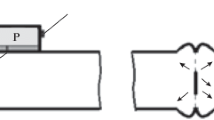Abstract
A modification of the SAFT method for obtaining flaw images in test objects containing three regions with different velocities of sound (SV) is proposed. Complex composite welded joints and repair welds are classified as objects in which the SV in a welded joint may differ from the velocity in a parent metal by >5%; therefore, a high-quality image of flaws can be obtained by taking different SVs into account. To solve this problem, a method for obtaining a test object with three regions with different SVs is proposed. The delays of propagating ultrasonic pulses were calculated using the Fermat principle. The results of reconstructing flaw images in a 300 welded joint from echo signals obtained as a result of numerical simulation by the finite-element method are presented. The images obtained by the SAFT method without taking different SVs into account are displaced from their true position, thus they do not allow determination of their coordinates and location. Consideration of different SVs allows one to obtain unshifted reflections of flaw images and, hence, evaluate the types and dimensions of flaws more accurately.
Similar content being viewed by others
References
Ogilvi, I.A., Ultrasonics Beam Profiles and Beam Propagation in Austenitic Weld Using a Theoretical Ray Tracing Model, Ultrasonics, 1986, no. 11, pp. 337–347.
Aleshin, N.P. and Gornaya, S.P., New Approach to Optimization of Austenitic Welded Joints, V Mire Nezrazrush. Kontr., 2003, no. 1 (19), pp. 16–18.
Thomson, R.N., A Portable System for High Resolution Ultrasonic Imaging on Site, Brit. J. Non-Destruct. Test., 1984, vol. 26, no. 7, pp. 281–285.
Johnson, J.A. and Barna, B.A., The Effects of Surface Mapping Corrections with Synthetic-Aperture Focusing Techniques on Ultrasonic Imaging, IEEE Transact. Son. Ultrason., 1983, vol. 30, no. 5, pp.283–294.
Plis, A.I., Babin, M.V., and Zheleznyakov, V.A., On the Problem of Direct Reconstruction of the Spatial Structure of Acoustic Sources, Pis’ma ZhTF, 1981, vol. 8, no. 2, pp. 83–86.
Akustika okeana (Acoustics of Ocean), Brekhovskikh, L.M., Ed., Moscow: Nauka, 1974.
Klei, K. and Medvin, G., Akusticheskaya okeanografiya (Acoustic Oceanography), Zhitkovskii, Yu.Yu., Ed., Moscow: Mir, 1980.
Kravtsev, Yu.A. and Orlov, Yu.I., Geometricheskaya optika neodnorodnykh sred (Geometrical Optics of Inhomogeneous Media), Moscow: Nauka, 1980.
Marklein, R., Langenberg, K.J., Mayer, K., et al., Recent Applications and Advances of Numerical Modeling and Wavefield Inversion in Nondestructive Testing, Advances in Radio Science, 2005, no. 3, pp. 167–174.
Shlivinski, A. and Langenberg, K.J., Defect Imaging with Elastic Waves in Inhomogeneous-Anisotropic Materials with Composite Geometries, Ultrasonics, 2007, vol. 46, no. 1, pp. 89–104.
Burov, V.A., Sergeev, S.N., and Shurup, A.S., The Role of Selection of Basis Functions in Problems of Acoustic tomography of Ocean, Akust. Zh., 2007, vol. 53, no. 6, pp. 791–808.
Goryunov, A.A. and Saskovets, A.V., Obratnye zadachi rasseyaniya v akustike (Inverse Scattering Problems in Acoustics), Moscow: Mosk. Gos. Univ., 1989.
Born, M. and Wolf, E., Principles of Optics, Oxford: Pergamon, 1970.
Rogers, D. and Adams, J., Matematicheskie osnovy mashinnoi grafiki (Mathematical Fundamentals of Computer Graphics), Moscow: Mir, 2001.
NVIDIA SUDATM Technology, httr://www.nvidia.ru/objest/suda-what_is_ru.htmlCUDA.
Zenkevich, O., Metod konechnykh elementov v tekhnike (Finite-Element Method in Technology), Moscow: Mir, 1975.
Bazulin, E.G., Vopilkin, A.Kh., and Tikhonov, D.S., Prospects of Applying Antenna Arrays for Automated Ultrasonic Testing, V Mire Nerazrush. Kontr., 2010, no. 3 (49) (in press).
Bazulin, A.E. and Bazulin, E.G., Deconvolution of Complex Echo Signals by the Maximum-Entropy Method in Ultrasonic Nondestructive Testing, Acoust. Zh., 2009, vol. 55, no. 6, pp. 772–783.
Author information
Authors and Affiliations
Corresponding author
Additional information
Original Russian Text © E.G. Bazulin, 2010, published in Defektoskopiya, 2010, Vol. 46, No. 11, pp. 3–13.
Rights and permissions
About this article
Cite this article
Bazulin, E.G. Obtaining flaw images by the SAFT method taking the variable velocity of sound in a test object into account. Russ J Nondestruct Test 46, 789–797 (2010). https://doi.org/10.1134/S106183091011001X
Received:
Published:
Issue Date:
DOI: https://doi.org/10.1134/S106183091011001X



